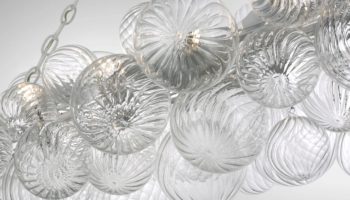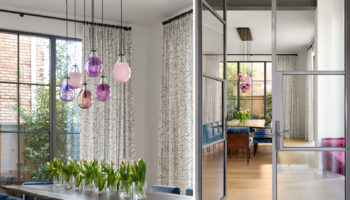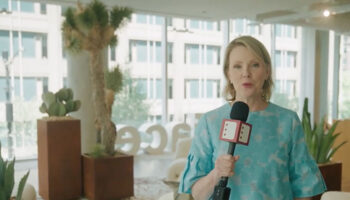Canlis Glass’ Aqueous Rain Drop Chandelier
Having taken a glass blowing class in college, I actually know the difficulty of making anything out of the material. Obviously, you can’t touch it, no matter how much you’d like to shape it into something even vaguely usable. The liquid glass comes from a not-so-comfortable 2,000°F furnace that singes your arm hairs as you dip in to collect the molten glass. The blowing is not as easy as it sounds either—and the blowpipe can burn you if you grab it too close to the end (sadly, I’m speaking from experience here).
Rain Drop Chandelier. Designed by Jean-Pierre Canlis for Canlis Glass.
The masterpiece of my glass blowing is a small bowl (like a salt pinch) that’s clear with purple and red striations—something I treasure as if it were The Great Star of Africa. My point, if you haven’t discerned it yet, is that beautiful hand-blown glass is a tremendous feat of craftsmanship and artistry. A real master can do wonders with the material, of course. And Jean-Pierre Canlis is one such expert. Canlis once worked under Dale Chihuly in Seattle, and then he and his wife Leigh started Canlis Glass in 1996. Recently completed in 2009, J.P. Canlis’ Rain Drop Chandelier fulfills his long-time vision. Composed of eight glass rain drops hanging from a 36″ round metal plate, the Rain Drop Chandelier is “modern and clean in its feel.” At 60″ high, the chandelier makes a dramatic statement, turning the natural into something unbelievably sculptural simply by magnifying it—the small raindrop at this large scale intensifies its simple, organic beauty. Canlis explains that “The options for commissioning this artwork are virtually endless!”

The Rain Drop Chandelier represents Canlis’ artistic vision of emphasizing “simplicity and completion.” Canlis clarifies his position: “Anyone can make something simple seem complex; it is taking the complex and translating it into the simplest form that inspires me. I want the viewer to walk away settled, feeling the art has a sense of completion.” His newest creation gets across all this and more. I’d like to see a great installation of Rain Drop Chandeliers used in a science museum or multi-level lobby. I’d love to see it used in Jeanne Gang’s Aqua skyscraper in Chicago—can’t think of a better fit, in fact.




Leave a Reply